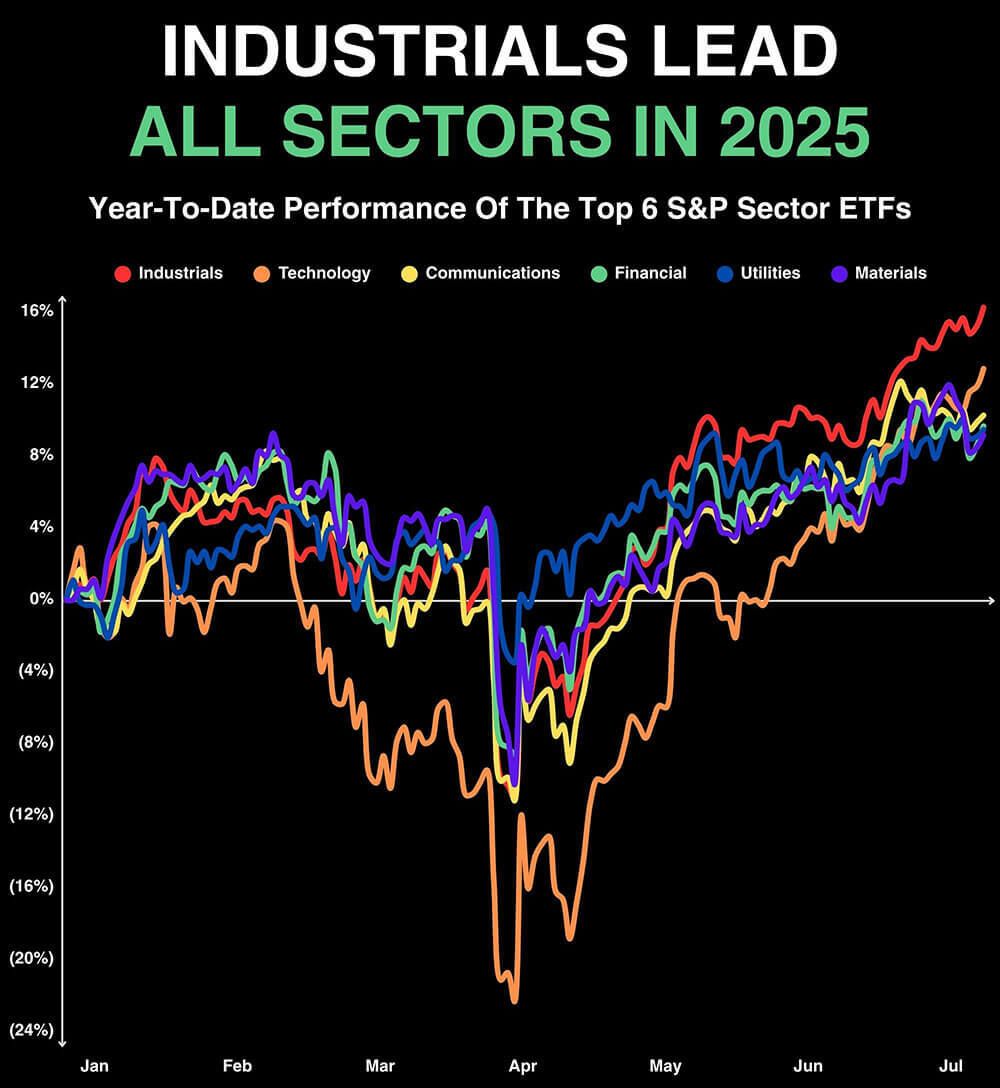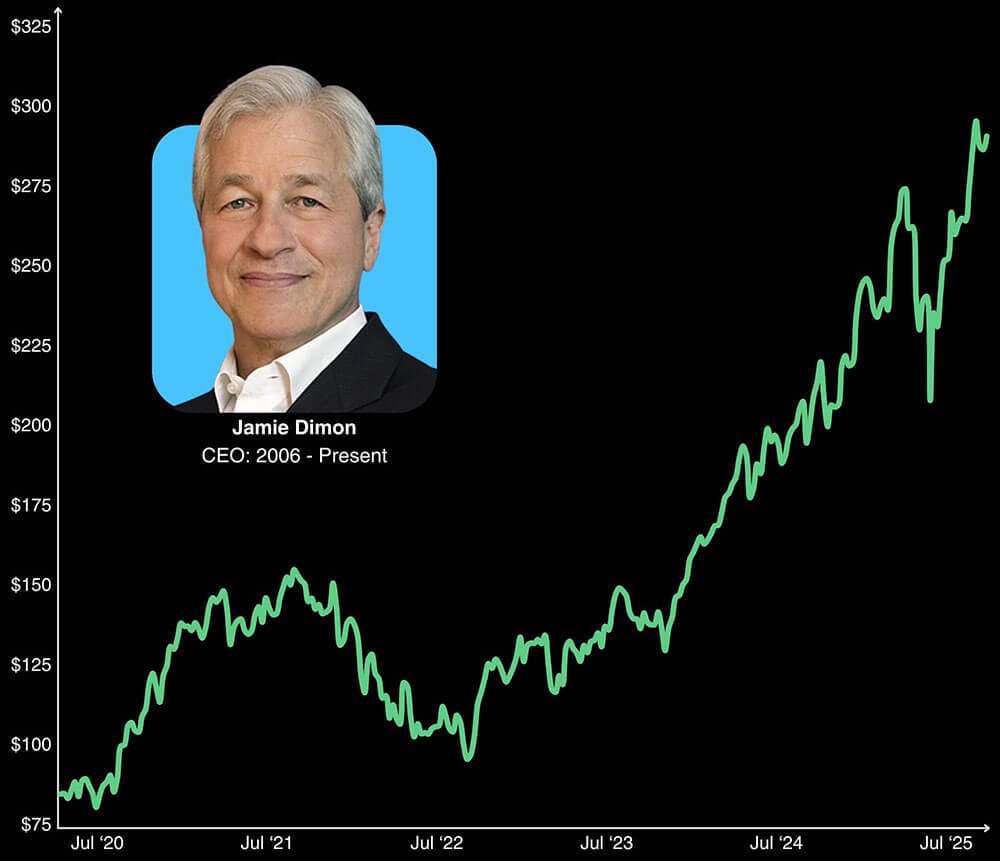- The Money Maniac
- Posts
- 💰 5 Fact Friday: Forget Tech, This Sector’s On Fire
💰 5 Fact Friday: Forget Tech, This Sector’s On Fire
While everyone’s watching Nvidia rip through resistance levels, another sector is quietly stealing the show in 2025: industrials.
Good morning, Maniacs!
Recession? Mostly off the table. Inflation? Creeping back into the chat. But the biggest surprise of late? The U.S. government ran a budget surplus in June.
Economists had forecasted a $42 billion deficit. Instead, we got a $27 billion surplus (the first since 2017), driven by a 301% jump in tariff collections.
“Why did God create economists? To make weathermen look good,” joked Carson Group strategist Ryan Detrick. Hard to argue.
Meanwhile, low earnings expectations are turning into fuel for this rally. Big banks outperformed. United Airlines raised its full-year outlook, saying conditions are now “less uncertain.” Netflix also delivered a solid beat and lifted guidance.
In short, the vibes are good.
The only real drama? A probe into whether Jerome Powell perjured himself about the $2.5 billion Federal Reserve office renovation. Is that budget absurd? Sure. But this feels more like a political sideshow than a market-moving event... unless it spirals.
Let’s dive in! 👇
STOCKS
1. The U.S. Goes Full Stack On Rare Earths 🧲
MP Materials $MP ( ▲ 4.72% ) just pulled off the rare feat of securing back-to-back mega-deals. First, it landed a $400M equity investment from the Pentagon. Then, it locked in a $500M supply agreement with Apple.
After the double scoop of government and Big Tech backing, the stock is now up 3x in the last 45 days. Why? Because the rare earth renaissance is here.
But first, a quick refresher.
Rare earths are a group of 17 minerals with names like dysprosium, praseodymium, terbium, and neodymium—aka the stuff on the periodic table that nobody ever studied.
These minerals power everything from EVs and wind turbines to missile guidance systems and MRI machines. They are critical.
Enter MP Materials. MP’s mine at Mountain Pass, California, is already the largest source of rare earths in the Western Hemisphere.
The problem? Mining them is just step one. Refining them into usable material is the hard (and dirty) part—and that’s where China dominates.
Historically, MP has shipped its raw concentrate to China, which controls a staggering 92% of refining capacity. But with rising tensions and national security risks, the U.S. is now racing to build a “mine-to-magnet” supply chain of its own.
That’s exactly what the Pentagon’s investment is designed to achieve.
The package—an initial $400M equity stake, up to $350M more, and a $150M loan—isn’t just funding a mine. It’s fueling a domestic empire capable of producing 10,000 metric tons annually by 2028.
The mission: eliminate America’s dangerous reliance on China and secure critical supply chains for AI, EVs, autonomous tech, energy, and defense.
Meanwhile, Apple’s deal aligns with its vision for “the future of American manufacturing”—a passion project that just so happened to gain steam as soon as tariffs arrived. 😉
From iPhones to F-35s, rare earths are everywhere. And in a world where the U.S. government can crown winners, this time it might’ve picked a gem. Since Uncle Sam took the top shareholder spot last week, taxpayers are already up 100%.
MARKETS
2. The Sleeper Trade of 2025 Is... Industrials 🏗️
While everyone’s watching Nvidia rip through resistance levels, another sector is quietly stealing the show in 2025: industrials.
The Industrials Select Sector ETF $XLI ( ▲ 0.87% ) is up 16% year-to-date, leading all sectors in the S&P 500. It includes companies that produce the physical goods and services behind manufacturing and construction—names like GE Aerospace, Honeywell, Caterpillar, RTX, and GE Vernova.
These firms are riding a wave of reshoring, defense spending, and AI-related infrastructure buildouts.
While headlines focus on semiconductors and nuclear innovation, industrials are doing the heavy lifting—literally.
With AI infrastructure booming, it turns out you need a lot more than just chips. You need the machines, tools, and power systems to build and run everything that supports them.
There are no signs of slowing down. Nearly every week brings news of another buildout.
Meta is the latest, with plans to construct gigawatt-scale data centers. These projects are helping drive forecasts that data centers will more than double their share of U.S. electricity demand, from 3.5% today to 8.6% by 2035.
That’s creating enormous tailwinds for firms that build turbines (GE Vernova), supply automation and building systems (Honeywell), manufacture heavy equipment (Caterpillar), and support the grid.
Policy tailwinds are also building.
The One Big Beautiful Bill Act allows 100% expensing for qualified property and equipment used in manufacturing, agriculture, and refining. That’s a game-changer for U.S. factory development and a huge tax break for capital-intensive projects.
In a world full of uncertainty, industrials are offering a rare combo: steady earnings, policy support, and real-world utility.
Unfortunately, your average “index and chill” portfolio doesn’t offer much exposure. Nvidia alone now makes up about 8% of the S&P 500. The entire industrials sector? Just 8.7%.
PERSONAL FINANCE
3. Markets Are Ripping. Should You Trim? ✂️
With the S&P 500 breaking past 6,300 and the Nasdaq notching fresh records, it’s clear the bulls are still running. Retail sales are holding up. Earnings are coming in strong. Even tariffs haven’t shaken the consumer.
So... should you be doing anything?
If you’re under 50 and investing for the long haul, probably not. In fact, it’s generally best to let your winners ride.
But if you’re approaching retirement, on a fixed income, or simply not interested in tolerating big swings, this is your reminder to check your asset allocation.
Asset allocation refers to the big-picture breakdown of your portfolio: how much you have in stocks, bonds, and cash. While you may have started with a plan—say, 60% stocks and 40% bonds—market rallies can throw things off.
That’s where rebalancing comes in.
This typically means selling some of your outperformers (likely stocks or crypto right now) and buying underperformers to bring your portfolio back in line.
Keep in mind, you do not want to rebalance too often, since that means constantly selling strength. But once or twice a year can be wise.
For example, if your 60/40 portfolio has drifted to 65/35, trimming back can help reduce downside risk in the event of a market correction.
This is especially important if you’re withdrawing income. Selling a little extra while markets are high can ease the pressure during rougher years.
Even if you remain optimistic, taking a few chips off the table at all-time highs isn’t a bad idea. If your priority is protecting downside rather than maximizing upside, a small trim can go a long way.
CRYPTO
4. Crypto Week Delivers Policy And Price Pops 🚀
It’s been a good week to be a crypto bull.
Bitcoin surged past $120K for the first time ever, briefly peaking at $123K. It now sits neck and neck with gold as one of 2025’s top-performing major assets.
Ethereum surged ahead, though—up 40% in the last month and a staggering 150% since its April lows.
But it wasn’t just prices that pumped. Washington delivered, too.
Congress passed the GENIUS Act, a bipartisan bill that creates the first federal framework for dollar-backed stablecoins. (For more on stablecoins, see recent editions here and here.)
The legislation, backed by President Trump and expected to become law any day, spells out how U.S. companies can issue and manage stablecoins for payments.
Two other crypto bills also cleared the House:
The CLARITY Act, which seeks to define how the SEC and CFTC oversee digital assets.
The Anti-CBDC Act, which aims to block the Federal Reserve from launching a U.S. central bank digital currency.
While the GENIUS Act waits for Trump’s signature, the other two bills now head to the Senate. Together, they represent the strongest push yet to bring crypto out of regulatory limbo and into the mainstream.
Altcoins surged on the news. There’s even speculation we’ve entered altcoin season—a late-stage bull market phase when non-Bitcoin tokens start to outperform.
Plus, crypto-adjacent stocks like Coinbase $COIN ( ▲ 1.32% ), Robinhood $HOOD ( ▲ 2.2% ), and Circle $CRCL ( ▲ 1.98% ) have been ripping higher.
With over $50B now poured into spot Bitcoin ETFs and Washington offering clearer guardrails, the industry may be entering its most legit phase yet.
The message from D.C.? Crypto’s no longer an outsider.
STOCKS
5. Guess That Stock 🕵️♂️
This financial titan is older than the Fed and bigger than its top three rivals combined.
Can you guess the stock?
The firm just reported its best-ever Q2 earnings. That brings its first-half profit to $30 billion, twice as much as its closest competitor.
With $4.6 trillion in assets and an $800 billion market cap, it’s the largest U.S. bank by a mile. It’s now worth more than Bank of America, Citigroup, and Wells Fargo combined.
The firm has acquired First Republic, WePay, Washington Mutual, Bear Stearns, Bank One, and Chase over the last 25 years.
The CEO has been in charge since 2006 and is often called “the voice of Wall Street.” He’s known for blunt takes on everything from Bitcoin to Fed independence and remote work.
Despite the CEO’s criticism of both crypto and private credit, the bank is now quietly getting involved in both. If you can’t beat ‘em...
Got a guess? Tap here for the answer →
Thanks For Reading!
How was today's email? |
Spread The Wealth 💸
Like what you read? Do me a favor and don’t keep it a secret! Send this newsletter to a friend and help them level up their financial game—one fact at a time.
Click the button above -or- copy and paste this link: https://read.themoneymaniac.com/subscribe?ref=PLACEHOLDER
DISCLAIMER: The information provided in this newsletter is for informational purposes only and should not be construed as financial advice or a solicitation to buy or sell any assets. All opinions expressed are those of the author and are subject to change without notice. Please do your own research or consult with a licensed professional before making any investment decisions.


Reply